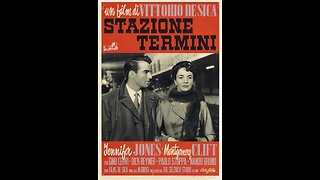Premium Only Content

The Inside Story (1948) | American comedy film directed by Allan Dwan
"The Inside Story" is a 1948 American comedy film directed by Allan Dwan. The film is a screwball comedy that revolves around a newspaper reporter who finds himself entangled in a series of comical and chaotic situations. Here is a detailed description:
The film follows the misadventures of Peter Miles (played by Marsha Hunt), a newspaper reporter working for a metropolitan daily. Peter is ambitious and eager to climb the ranks in the competitive world of journalism. One day, she stumbles upon a potentially explosive story involving a powerful and corrupt businessman, which she believes could be her ticket to success.
Complications arise when Peter's boyfriend, Eddie Martin (played by William Lundigan), is mistakenly identified as the businessman's son. The confusion leads to a series of misunderstandings, and soon, Peter finds herself caught in a whirlwind of chaos. As she attempts to navigate the complexities of the situation, the film unfolds in a fast-paced and comedic manner.
"The Inside Story" combines elements of romance, mistaken identity, and witty banter, typical of the screwball comedy genre. The film explores the dynamics of the newspaper industry, highlighting the frenetic and often absurd nature of chasing a breaking story.
Throughout the film, Peter must juggle her professional aspirations with her personal life, leading to humorous situations and a quirky mix of characters. As the plot unfolds, the characters find themselves in increasingly absurd scenarios, and the film uses humor and satire to comment on the challenges and absurdities of the newspaper business.
While "The Inside Story" may not be as widely remembered as some other classic comedies of the era, it is appreciated for its lighthearted and entertaining approach to storytelling. Allan Dwan's direction and the performances of the cast contribute to the film's charm. As with many films of the screwball comedy genre, "The Inside Story" reflects the comedic sensibilities of its time and provides a glimpse into the style of humor prevalent in 1940s cinema.
-
 1:28:31
1:28:31
Classic Films & Movies Archive
9 days agoTerminal Station (1953) | Directed by Vittorio De Sica
263 -
 2:02:36
2:02:36
Badlands Media
2 hours agoBadlands Daily: August 5, 2025
22.2K11 -
 1:18:04
1:18:04
The Big Mig™
5 hours agoRussia Collusion Hoax + Grand Jury + Indictments = ARRESTS
3.95K10 -
 LIVE
LIVE
LFA TV
16 hours agoLFA TV ALL DAY STREAM - TUESDAY 8/5/25
4,894 watching -
 25:13
25:13
Stephen Gardner
2 hours ago🔥Trump White House makes TWO HUGE ANNOUNCEMENTS!
9.62K36 -
 1:44:53
1:44:53
Dear America
4 hours ago🔥 DEMS ON THE RUN: Hunted, Arrested in Texas! Bondi DEMANDS Grand Jury for Russia Hoax!!
94.1K81 -
 DVR
DVR
Law&Crime
3 hours agoLIVE: Wife Dismembered Murder Trial – GA v. Nicholas Kassotis – Day 1
17.5K -
 LIVE
LIVE
JuicyJohns
3 hours ago $0.99 earned🟢#1 REBIRTH PLAYER 10.2+ KD🟢$500 GIVEAWAY SATURDAY!
95 watching -
 2:19:31
2:19:31
Matt Kohrs
13 hours agoMarket Open: Swings Incoming, Earnings Update & Breaking News || Live Trading
31.3K1 -
 41:42
41:42
Randi Hipper
2 hours agoBITCOIN NEWS FROM RANDI'S NEW STUDIO
15.4K1